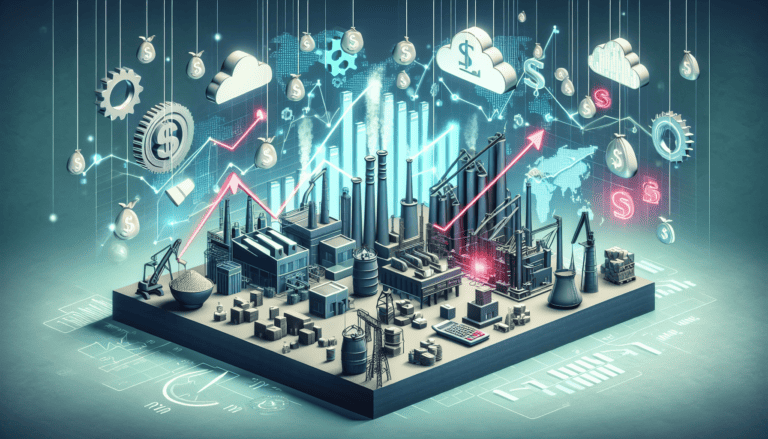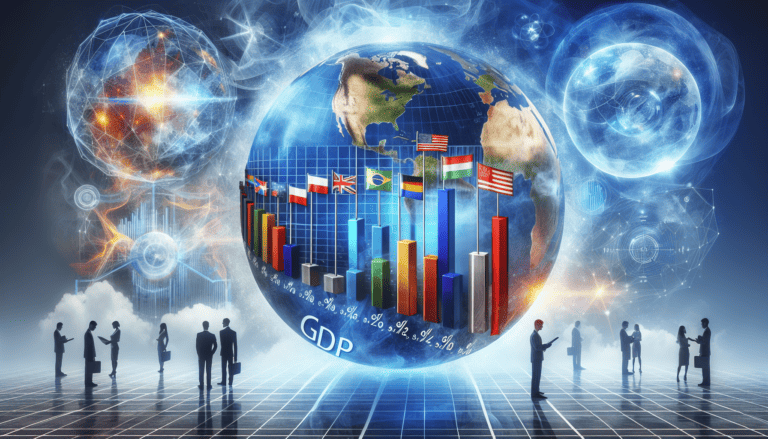Unveiling Economic Insights: PMI Manufacturing and Services Sectors

Understanding Economic Indicators
Economic indicators are critical tools for investors, analysts, and policymakers, providing data on the performance and trends of an economy. These indicators can influence financial market dynamics and are essential for making strategic decisions.
The Role of Economic Indicators
Economic indicators are statistics that provide information about the economic activities and health of a country. They are used to analyze economic performance, predict future trends, and guide investment and policy decisions. For investors, particularly those new to the financial markets, understanding these indicators is vital for identifying investment opportunities and managing risks.
Economic indicators can be categorized based on what they indicate about the current state of the economy or their predictive value. Leading indicators, such as the Purchasing Managers Index (PMI), offer a glimpse into the future direction of the economy. Lagging indicators, such as unemployment figures, confirm trends that are already underway. Coincident indicators, like retail sales data, provide a snapshot of the current state of economic affairs.
Types of Economic Indicators
Economic indicators come in various forms, each serving a specific purpose in financial analysis. Here are some of the most significant types:
- Leading Indicators: These predict future economic activity and include indicators like the PMI, business confidence surveys, and housing market indicators.
- Lagging Indicators: These reflect economic performance after trends have been established, such as unemployment rates and government budget deficits.
- Coincident Indicators: These occur at the same time as the conditions they signify. Examples include personal income and the Consumer Price Index (CPI).
Investors can also look at indicators like inflation rates, which impact interest rate decisions by central banks, and GDP growth, which gives a broad overview of economic expansion. Other indicators include commodity prices, non-farm payrolls, and the Producer Price Index (PPI).
Economic indicators are indispensable for forming a comprehensive view of economic health and guiding investment strategies. They offer the foundational knowledge needed for beginner investors to navigate the complexities of financial markets and make informed decisions.
Breaking Down the PMI
The Purchasing Managers’ Index (PMI) is a pivotal gauge for investors, providing a snapshot of the economic health of the manufacturing and services sectors. Understanding the PMI is essential for beginner investors seeking to grasp the underpinnings of financial markets and economic indicators.
PMI Explained
The PMI is an index of the prevailing direction of economic trends in the manufacturing and service sectors. It is constructed from responses to questionnaires sent to purchasing managers in a panel of companies within these sectors. The PMI is a significant economic indicator because it provides early insights into the health of the sectors that are crucial for economic growth. According to S&P Global, the PMI serves as a leading indicator, offering advanced signaling of market trends and helping companies worldwide to make informed decisions.
Components of PMI
The PMI is composed of five key areas, which are:
- New Orders
- Inventory Levels
- Production
- Supplier Deliveries
- Employment Environment
Each component carries a different weight in the computation of the PMI. For instance, New Orders might have a more significant impact than Inventory Levels. The PMI is a composite index, meaning it is derived from the weighted sum of these individual indicators.
Interpreting PMI Values
The PMI is expressed as a number between 0 and 100. A PMI reading above 50 represents an expansion of the manufacturing or service sector compared to the previous month, while a reading below 50 signifies a contraction. The further from 50 the PMI value is, the greater the level of change. A value of exactly 50 indicates no change in the level of business conditions compared to the prior month.
| PMI Value | Sector Trend |
|---|---|
| Above 50 | Expansion |
| Below 50 | Contraction |
| Equal to 50 | No Change |
This information, sourced from Investopedia, is particularly useful for investors as they evaluate inflation rates and financial markets, unemployment figures and economic health, and other correlated economic indicators.
The PMI is also seasonally adjusted to filter out influences that could be attributed to predictable annual variations in the market, allowing investors to focus on genuine economic trends. Understanding these nuances is key for investors to make informed predictions about market movements and align their investment strategies accordingly. For further insights on economic indicators that can impact investment decisions, consider exploring resources on housing market indicators and trends and manufacturing and industrial production indexes.
PMI in Manufacturing
The manufacturing sector is a significant component of the economy, and tracking its health is vital for investors, policymakers, and business leaders. The Purchasing Managers’ Index (PMI) serves as a barometer for the manufacturing industry, providing early insights into the sector’s performance.
Manufacturing PMI Overview
The PMI is an economic indicator derived from monthly surveys of private sector companies. A PMI reading above 50 indicates that the manufacturing economy is generally expanding, while a reading below 50 suggests it is contracting. The further the index is above or below 50, the faster the respective expansion or contraction (Investopedia).
The PMI for the manufacturing sector is particularly important as it reflects the economic activities within the sector and is often used to predict the manufacturing trends. It is based on five major indicators: new orders, inventory levels, production, supplier deliveries, and the employment environment (Investopedia).
For example, the United States Manufacturing PMI for October 2021 stood at 60.8, marking the 19th consecutive month of expansion in the sector (Investing.com). This type of data is crucial for understanding the health of the manufacturing industry and can be further explored by examining manufacturing and industrial production indexes.
Analyzing Current Trends
To analyze current trends in the manufacturing sector, one must look at the PMI’s historical data and the factors affecting its movements. For instance, economic events, such as changes in interest rate decisions by central banks or inflation rates and financial markets, can significantly influence the PMI.
A country-by-country analysis can also reveal regional dynamics and global supply chain impacts. For example, the manufacturing industry in India plays a critical role in driving the country’s economic growth, with India maintaining a GDP growth rate of 6.9% in 2021 despite the challenges posed by the COVID-19 pandemic (Medium).
By examining these trends, investors and business leaders can anticipate changes in the economic landscape and make informed decisions, such as adjusting investment portfolios or strategic business operations. For a deeper understanding of economic indicators and their impact on financial markets, readers can explore global economic indicators and interconnectivity and consumer price index (CPI) explained.
PMI in Services Sector
The Purchase Managers’ Index (PMI) is not only a fundamental indicator of the manufacturing sector’s health but also serves as a critical gauge for the services sector. The services sector encompasses a broad range of industries, from finance and healthcare to hospitality and retail, and its performance is pivotal to overall economic health.
Services Sector PMI Overview
The PMI for the services sector mirrors the one for the manufacturing sector, reflecting the direction and pace of change in the services industry each month. As detailed by Investopedia, this indicator is essential for understanding the state of the economy. A PMI above 50 indicates expansion within the services sector, while a value below 50 suggests contraction. It is a vital metric that central banks, financial markets, and business leaders use to make informed decisions regarding monetary policy and investment strategies.
Analyzing Services Sector Health
To assess the health of the services sector, the PMI report delves into several key factors:
| Factor | Description |
|---|---|
| New Orders | Demand for services |
| Production | Volume of services provided |
| Employment | Hiring within the sector |
| Supplier Deliveries | Efficiency and speed of supply chain |
| Inventories | Stock levels maintained by service providers |
Each of these components contributes to the overall PMI score and offers insights into economic activity and trends within the services sector. The employment element, for instance, can be correlated with unemployment figures and economic health, while new orders may reflect consumer confidence and spending patterns.
PMI reports offer more than just a snapshot of current sector performance; they provide a forward-looking perspective, which is why they are considered valuable tools for decision-making processes in business and investment. The data collected through PMI surveys helps gauge overall economic activity and is often aligned with other indicators such as consumer confidence index and spending behavior, retail sales data and market sentiment, and government budget deficits and public debt.
In summary, the PMI for the services sector is a robust tool that helps decode the complexities of the economy, offering both current and predictive insights. For investors and policymakers alike, understanding the nuances of this indicator is crucial for navigating the financial landscape and anticipating future market dynamics. To explore how PMI intertwines with other economic indicators, consider reading about the consumer price index (CPI) explained or discovering the relationship between commodity prices as economic indicators and market fluctuations.
PMI’s Impact on Financial Markets
The Purchasing Managers’ Index (PMI) is a vital tool for investors and business leaders globally. As an economic indicator, PMI provides crucial insights into the manufacturing and services sectors, influencing financial markets and investment decisions.
PMI as a Leading Indicator
PMI is often considered a leading indicator, forecasting economic health before official data becomes available. As PMI encapsulates the momentum of economic activities, including new orders, inventory levels, production, supplier deliveries, and the employment environment, it offers a peek into the future of the economy (Investopedia).
Financial markets closely watch PMI reports to predict the pace of economic growth and adjust their strategies accordingly. A PMI reading above 50 suggests expansion in the industry, signaling potential growth in the economy and possibly leading to bullish market trends. Conversely, a PMI below 50 indicates contraction, which could trigger caution among investors.
PMI’s Influence on Investment Decisions
Investors leverage PMI data to gauge the economic landscape and make informed decisions. PMI figures can trigger immediate reactions in the stock market: a rise in PMI might lead to an uptick in share prices, while a drop may result in market pullbacks as investors anticipate a downturn in economic conditions (Investopedia).
PMI also influences other financial instruments. For instance, bond markets may respond to PMI data as it affects interest rates and inflation expectations. In currency markets, strong PMI data from a country could strengthen its currency, reflecting robust economic health.
The comprehensive analysis provided by PMI assists not just in investment decisions but also in policy-making. Central banks consider PMI when setting monetary policies (business confidence and investment surveys), while businesses use PMI to plan inventory and production levels (manufacturing and industrial production indexes).
To sum up, PMI is a crucial cog in the financial market mechanism, offering foresight into economic trends and shaping the decision-making process for investors and policymakers alike. Understanding PMI’s role and its implications can empower beginner investors to navigate the investment landscape with greater confidence. For more on how economic indicators impact financial markets, explore inflation rates and financial markets and interest rate decisions by central banks.
Global Insights from PMI
The Purchasing Managers’ Index (PMI) serves as a global barometer of economic health, providing investors, analysts, and policymakers with critical insights into the manufacturing and services sectors across various countries. Through the PMI, stakeholders can glean valuable information about potential shifts in economic conditions and business activities.
PMI Across Countries
PMI reports for individual countries or regions are instrumental in offering early indicators of economic health. These reports are provided by the Markit Group and other organizations, compiling data that reflect the economic vigor of the manufacturing and services sectors. The PMI is an influential tool, closely monitored due to its timeliness and detailed signal of economic well-being in a country Investopedia.
| Country | Manufacturing PMI | Services PMI |
|---|---|---|
| United States | 53.2 | 55.3 |
| United Kingdom | 48.9 | 50.1 |
| Germany | 45.8 | 51.7 |
| China | 50.6 | 52.2 |
| Japan | 49.0 | 51.4 |
*The above figures are illustrative examples and not actual data.
PMI data are released separately for different sectors, such as manufacturing and services, providing a detailed view of the overall economy. These data are seasonally adjusted to account for predictable annual fluctuations affecting both sectors Investopedia.
For a more comprehensive understanding of economic indicators, readers can explore related topics such as inflation rates and financial markets and unemployment figures and economic health.
PMI and Global Market Dynamics
The PMI influences global market dynamics by providing insights into new orders, production, employment, supplier deliveries, and inventories. This information helps gauge overall economic activity and trends Investopedia. When PMIs indicate expansion (above 50), it can lead to bullish market sentiment, whereas contraction (below 50) may trigger bearish reactions.
Investors often use PMI data to make informed decisions about asset allocation. A robust PMI reading might encourage investment in equities or commodities associated with economic growth, while a weak PMI could lead to a shift towards more defensive assets like bonds or safe-haven currencies.
For investment-related decisions, PMI must be considered alongside other indicators such as consumer price index (CPI) explained, housing market indicators and trends, and business confidence and investment surveys. Understanding these correlations is essential for grasping global economic indicators and interconnectivity.
In summary, the PMI serves as a vital tool in the financial markets, offering insights into the health of manufacturing and service sectors across the globe. Its impact on investment decisions and market dynamics underscores its importance in economic analysis and policymaking.
PMI and Policy Making
Policy makers utilize a range of economic indicators to guide strategic decisions. The Purchasing Managers’ Index (PMI) is one such tool that provides insights into the economic health of the manufacturing and services sectors. This index is critical for shaping monetary policy, fiscal initiatives, and other regulatory measures.
PMI in Strategic Decisions
PMI data is frequently employed by central banks and other policy-making bodies to assess the current state of the economy. The index’s components, including new orders, production, employment, supplier deliveries, and inventories, offer a comprehensive overview of economic conditions. This allows for targeted interventions aimed at stimulating or cooling the economy as needed. For example, a persistently low PMI may prompt a central bank to consider cutting interest rates to encourage borrowing and investment (Investopedia).
PMI reports also help businesses make informed decisions on inventory levels, production schedules, and workforce adjustments. For instance, a rising PMI could signal growing demand, prompting companies to ramp up production and potentially invest in new capacity. Such strategic decisions ultimately contribute to economic growth and stability.
PMI’s Role in Economic Forecasting
PMI is not only a reflection of the current economic landscape but also serves as a forward-looking indicator. The index can signal the direction in which the economy is heading, which is invaluable for economic forecasting (Investopedia). An upward trend in PMI may indicate future expansion, while a downward trend could suggest a potential slowdown or contraction.
This predictive quality of PMI is particularly useful for anticipating changes in other related economic indicators, such as GDP growth, unemployment rates, inflation, and consumer spending. Policy makers can use PMI trends to adjust fiscal policies, prepare for upcoming economic challenges, and communicate with the public and investors about expected economic conditions.
The detailed analysis provided by PMI, covering sector strengths and weaknesses, empowers policy makers to devise strategies that promote sustainable growth. By understanding which sectors are expanding or contracting, governments can allocate resources more effectively, support industries in need, and foster a favorable business environment (Medium).
In summary, PMI plays a pivotal role in both strategic decision-making and economic forecasting, influencing a wide range of policy decisions from interest rates and tax policies to trade agreements and government spending. As a leading indicator, PMI provides early signals about the economic trajectory, aiding policy makers in their efforts to maintain economic stability and promote growth.





